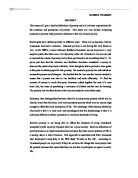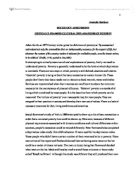There are two main ways of measuring poverty according to the relative definition. The first is to take the governments own level of income support plus an allowance for housing etc, which adds up to approximately another 40% of the income support as a guide to poverty. The reasoning behind this is that income support reflects the minimum level of income the government itself believes it is reasonably possible to live on. So poverty equals 140% of income support. The figures are based on the low income family’s statistics. An alternative method which came to be used by the UK government in the Households Below Average Income (HBAI) is to say that having less than 50% of average income, adjusted for family size is an approximate guide to poverty.
The advantages of the relative approach is that it relates poverty to expectations in society generally and it gives a realistic picture of deprivation within modern society, and it also broadens the idea of what poverty is, from basic necessities to a range of other needs that people in a society have, and which make like bearable. The disadvantages is that it is taken to its extreme, this approach means that as long as there is inequality there is poverty and it could be argued that simply because someone does not have the extras which others enjoy this does not make them poor.
The consensual definition of poverty is when you don’t have the things that everyone agrees are necessities. This method was first devised in 1985 for the television programme Breadline Britain and then used in follow up studies in 1991 and 1999. In the consensual approach a sample of the public were asked to rank in order of importance what they consider to be necessities for life in Britain. Any item which more than 50% of respondents selected was included in the definition of poverty. In 1985 and 1991, Mack and Lansley asked over 1,000 people what they thought ‘necessities’ were, and then from their replies made a list of the most commonly agreed necessities.
A new term which has recently emerged in discussions of poverty is ‘social exclusion’. Social exclusion means facing a wide range of physical, financial and social problems which make the quality of life very poor. In many ways it is similar to the relative definition but it involves much more than looking at income, as it includes many other factors which shape life chances, such as health, education, security and general participation in society. Social exclusion means being shut out of the economic, political and cultural systems which make up social life, so that excluded people are no longer integrated and do not feel that they are a full member of society. The governments report on social exclusion involves 24 separate measures across 9 areas which apply to both individuals and neighbourhoods. These are intended to provide an annual calculation of social exclusion so that the success or failure of government welfare policies can be measured.
There are two explanations for the causes of poverty. The first stresses the process of dependency, and the second stresses the process of exclusion. Explanations which centre around the concept of dependency often stress that people who are in poverty are there because of some failing in themselves or the particular social group to which they belong. Within this approach to explaining the causes of poverty, we can distinguish blaming the individual, the underclass and the culture of poverty.
The individual means that poverty is a result of the failure of the individual to achieve success through his or her own efforts. People who are poor are lazy or incompetent, and should try harder. The underclass is a more subtle development of the individual explanation and suggests that a distinct ‘underclass’ exists of people who are lazy and who make no effort to work or look after themselves. These people prefer to live off the state rather than having to work. The idea of the underclass has been strongly criticised as there is little or no evidence that there is an identifiable group of people with these distinctive values, who just want to sponge off the state. The majority of people want to work and support their family.
Culture of poverty refers to people who have a particular culture which prevents them being successful in society and so keeps them in poverty. This approach stresses that the way people act is the result of how they are brought up by their family. It differs from the underclass explanation because it does not see poverty as a fault of the person. It stresses that individuals are brought up in such a way that they never have a chance to escape the poverty of their parents.
The culture of poverty argument was first developed by Oscar Lewis when he studied very poor people in Central Amercia. The values and behaviour (the culture) of these poor people was significantly different from the majority of the population. Lewis argued that this was because these particular values enabled the very poor to cope with circumstances which would otherwise lead to despair and hopelessness.
A development from the culture of poverty argument is the claim that a cycle of poverty, or a cycle of transmitted deprivation, exists. This explanation concentrated on the way in which some poor people failed to help and support their children, for example, by not encouraging them to work hard at school. The result was school failure and another generation condemned to poverty.
The second set of explanations for poverty are based on the idea of exclusion – meaning that the poor are in that situation because they are squeezed out of a decent standard of living by the actions of others. This approach stresses differences in power between the various groups in society. Those who lose out – disabled people, older people, women, people from ethnic minorities and of course, children – have significantly higher chances of living in poverty. Within this explanation, we can distinguish two approaches, the dyswelfare view and the Marxist-based view.
Dyswelfare refers to the process in which some people lose out in complex industrial societies through no fault of their own. They are the casualties of industrial and social change. The ‘victims’ of dyswelfare include physically or mentally disabled people, lone parents and so on. The points to emphasise here are that their poverty is blameless and is the result of changes in the nature of society, secondly a society does not deliberately discriminate against any group, but it is inevitable that some people will lose out in any form of society.
The final and most radical explanation for the continuation of poverty comes from those who argue that society is a competition between various groups. Some groups have considerably more power than others and are able to impose their will on the rest of society. Power and wealth generally go together, as do poverty and powerlessness.
The groups in poverty and largely formed from the powerless, in particular women, children and people from ethnic minorities. Low pay and poor state benefits result from the view that to pay more would be harmful to the interests of those who are more affluent. This approach contrasts with the dyswelfare explanation because it says that poverty is the direct result of the intended development of modern western society.
There are various policies to try and combat poverty. These include changing the tax system to give money to those on low wages, this is good as it eliminates the poverty trap, but could end up subsidising low pay by employees. There is also the minimum wage but this is only good if people are in employment and if the minimum wage is high enough to eliminate poverty.
Another way to eradicate poverty is to ensure people are in full time employment but this is out of the governments hands and would only eliminate poverty if wages/pensions are adequate. It has also been mentioned to increase the level of state benefits; this would be very expensive and would attract those who would prefer not to work. There is also a free market which is no government interference or at least as little as possible. This would definitely cause an increase in poverty for some if not a majority of the population.
There is a considerable dispute over how to define and measure poverty. Social policy analysts have suggested several different ways to define poverty; absolute, relative, consensual and social exclusion. Each of these is linked to different forms of measurement. The different definitions and measurements will produce different figures as to the numbers in poverty and the extent of the problem.
REFERENCES
Moore, S (2001) ‘Sociology Alive’ (Third Edition) Nelson Thornes, UK







